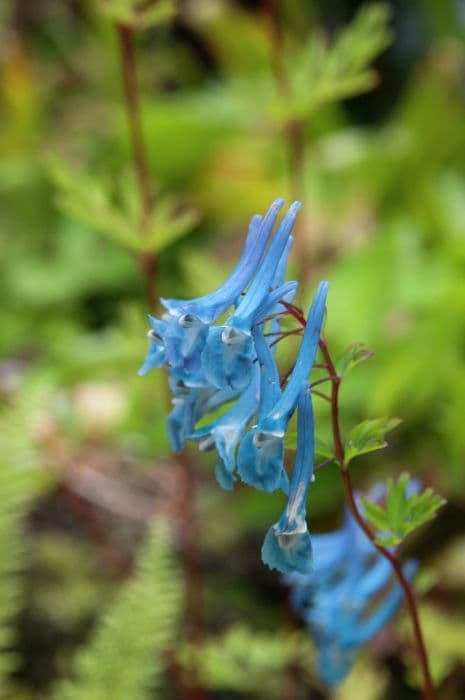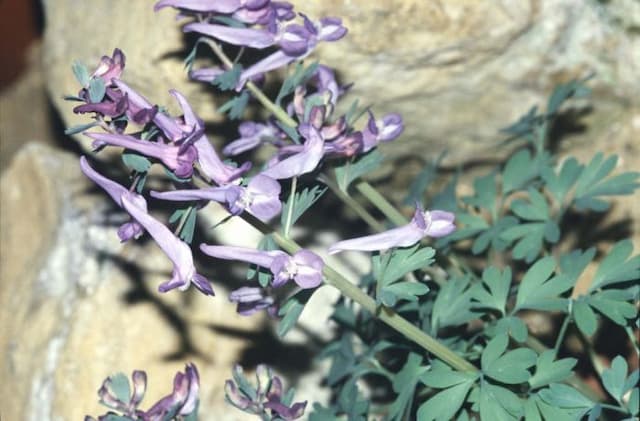Meconopsis (Infertile Blue Group) 'P.c. Abildgaard'

ABOUT
The Meconopsis 'P.c. Abildgaard', commonly known as the Himalayan blue poppy, boasts striking features that are a true spectacle in the garden. This plant is distinguished by its captivating flowers, which are an intense shade of blue, a color rarely found in the botanical world. Each blossom presents with delicate, soft, almost silky petals that look as if they’ve been painted by a master artist. The rich blue is sometimes accented with a hint of purple, making the flowers stand out with an iridescent quality. At the center of the bloom, contrasting golden yellow stamens form a striking halo, creating a beautiful contrast against the blue petals. These stamens, the male reproductive part of the flower, add an extra layer of interest and allure to the overall appearance. The leaves of the Himalayan blue poppy are rich green, a perfect backdrop to showcase the brilliance of the flowers. These leaves are generally broad, with a somewhat ruffled or serrated edge, giving them a somewhat textured look and feel. The foliage forms a mound from which the flower stems emerge, bearing the buds that unfurl into the resplendent blue display. As a clump-forming perennial, the plant has a lush appearance, with its dense foliage providing a verdant grounding to the upward-facing blooms. Adding to its beauty, the flowers exhibit a gentle nodding or bobbing in the breeze, an enchanting dance that adds dynamic movement to the garden space. The Himalayan blue poppy's appearance, with its gorgeous blue flowers and rich green leaves, has a truly magical, almost ethereal quality that can bring a piece of Himalayan serenity to any garden setting.
About this plant
 Names
NamesFamily
Papaveraceae
Synonyms
Himalayan Blue Poppy, Tibetan Blue Poppy
Common names
Meconopsis (Infertile Blue Group) 'P.c. Abildgaard'.
 Toxicity
ToxicityTo humans
The plant commonly known as Himalayan blue poppy is not generally considered toxic to humans. However, ingesting any part of this plant is not advisable, and if symptoms of poisoning do occur after ingestion, medical advice should be sought.
To pets
The Himalayan blue poppy is not typically toxic to pets either. Nonetheless, it is not intended for consumption, and pets should be prevented from ingesting this plant. If a pet does consume it and exhibits signs of distress, a veterinarian should be consulted.
 Characteristics
CharacteristicsLife cycle
Perennials
Foliage type
Deciduous
Color of leaves
Green
Flower color
Blue
Height
2-3 feet (60-90 cm)
Spread
1-2 feet (30-60 cm)
Plant type
Herb
Hardiness zones
5
Native area
Himalayas
Benefits
 General Benefits
General Benefits- Ornamental value: The Meconopsis, commonly known as the Himalayan Blue Poppy, is highly regarded for its striking blue flowers, adding a unique color rarely seen in the plant world to gardens.
- Attracts pollinators: With its vivid blooms, it attracts bees, butterflies, and other beneficial pollinators, supporting local ecosystems.
- Shade tolerance: The Himalayan Blue Poppy thrives in shady conditions where other flowers might struggle, making it an ideal plant for woodland gardens.
- Cool climate adaptation: It is particularly well-suited for cooler climates, which replicate its native Himalayan habitat, offering a flowering option for gardeners in such regions.
 Medical Properties
Medical PropertiesThis plant is not used for medical purposes.
 Air-purifying Qualities
Air-purifying QualitiesThis plant is not specifically known for air purifying qualities.
 Other Uses
Other Uses- The striking blue petals of the Himalayan Blue Poppy can be used to create natural dyes for textiles, imparting delicate shades of blue and green when mordants are applied.
- The plant can serve as an educational tool in botanical gardens and schools, providing insight into the delicate requirements needed for growing alpine plants.
- Himalayan Blue Poppy's attractive foliage and unique flowers make it a popular subject for botanical illustrators and photographers, inspiring artwork and providing visual content for publications.
- Since these plants require cool temperatures and specific soil conditions, they are sometimes used in research to study the impact of climate change on alpine flora.
- Their seed pods, once dried, add an exotic look to floral arrangements and can be used in the creation of natural jewelry or ornaments.
- The contrasting colors of leaves and vivid blue flowers can be used in landscape design to create 'cool' color palettes or thematic garden sections.
- In colder regions, cultivating Himalayan Blue Poppies can be considered a challenge for advanced gardeners, thus rewarding their skill with its rare beauty.
- During cultural festivals or garden shows, they can be displayed as a symbol of rarity and splendid beauty, attracting visitors and plant enthusiasts.
- These flowers can be used as a peaceful reflection tool in mindfulness gardens, where their serene appearance helps to foster a tranquil environment.
- In some cultures, the Himalayan Blue Poppy is incorporated into poetry and literature as a symbol of fleeting beauty, often connected to themes of desire and loss.
Interesting Facts
 Feng Shui
Feng ShuiThe Blue Poppy is not used in Feng Shui practice.
 Zodiac Sign Compitability
Zodiac Sign CompitabilityThe Blue Poppy is not used in astrology practice.
 Plant Symbolism
Plant Symbolism- Rarity: The Meconopsis, commonly known as the Himalayan Blue Poppy, is rare and difficult to grow in most gardens, symbolizing uniqueness and the value of scarce beauty.
- Peace: With its serene blue hues, the Himalayan Blue Poppy represents peace and tranquility, evoking a calming presence.
- Imagination: The unusual blue color of the poppy is emblematic of imagination and creativity, inspiring thoughts beyond the ordinary.
- Success: Due to the challenges involved in cultivating this plant, it symbolizes success after a long struggle or the triumph of perseverance.
 Water
WaterThe Himalayan Blue Poppy, Meconopsis 'P.c. Abildgaard', prefers consistently moist soil, so water the plant thoroughly whenever the top inch of soil begins to dry out. In general, this may mean watering with 1 to 2 gallons every week, but frequency can vary based on temperature and humidity levels. Avoid waterlogging the soil as this can lead to root rot. It's crucial to use a gentle watering method to avoid disturbing the soil or damaging the delicate foliage, such as a watering can with a sprinkle attachment or a low-pressure hose.
 Light
LightHimalayan Blue Poppies thrive in light conditions that are bright but shielded from direct sunlight. A spot that receives dappled sunlight or partial shade is ideal, which will protect their delicate petals from harsh rays. East or north-facing locations that provide morning light or late afternoon sun are usually the best for maintaining the vibrant colors of the blooms without causing stress to the plant.
 Temperature
TemperatureThe Himalayan Blue Poppy does best in cool temperature conditions, ideally between 50 to 65 degrees Fahrenheit. They can survive a range down to around 32 degrees but should not be exposed to prolonged frosts. The plants are not heat-tolerant and can struggle when temperatures rise consistently above 70 degrees Fahrenheit, so it's important to provide a cooler environment during hot weather.
 Pruning
PruningHimalayan Blue Poppies do not require regular pruning, but deadheading spent flowers can encourage additional blooming and maintain the plant's appearance. The best time to prune is right after the blooms have faded, carefully removing just the spent flower stem. Avoid heavy pruning as these plants can be delicate and do not respond well to hard cutting back.
 Cleaning
CleaningAs needed
 Soil
SoilMeconopsis, commonly known as Himalayan Blue Poppy, requires a soil mix that is rich in organic matter, well-draining, and has a pH range of 6.0-7.5. A mix of two parts loam, one part leaf mold or peat, and one part sharp sand or perlite can be ideal for these plants to thrive.
 Repotting
RepottingHimalayan Blue Poppies should be repotted every one to two years to prevent root crowding and ensure nutrient-rich soil. They have delicate roots that should be handled carefully during repotting.
 Humidity & Misting
Humidity & MistingHimalayan Blue Poppies perform best in high humidity environments, often thriving in conditions with 60% to 80% humidity. It is essential to maintain consistent humidity to mimic their native mountainous habitats.
 Suitable locations
Suitable locationsIndoor
Provide cool, humid conditions and filtered light indoors.
Outdoor
Plant in partial shade, moist, rich soil, protect from wind.
Hardiness zone
5-7 USDA
 Life cycle
Life cycleThe Himalayan Blue Poppy (Meconopsis Infertile Blue Group 'P.c. Abildgaard') begins its life cycle as a seed, typically requiring a period of cold stratification to break dormancy and germinate. Upon germination, the seedling emerges and develops its first leaves, entering the vegetative growth stage where the plant focuses on leaf and root development. As the plant matures, it forms a rosette of leaves at the base before initiating the flowering stage, where tall flower stalks are produced topped by the characteristic stunning blue blooms. After flowering, being part of the infertile group, this cultivar does not produce viable seeds; it relies on vegetative propagation or division for reproduction. The plant then may enter a period of dormancy, especially in colder climates, where it conserves energy for the next growing season. This cycle repeats, with mature plants typically flowering once each year during the summer months, given appropriate growing conditions.
 Propogation
PropogationPropogation time
Spring to Early Summer
The Meconopsis, commonly known as the Himalayan blue poppy, is a challenging plant to propagate, primarily due to its infertility issues within certain cultivated groups, such as 'P.c. Abildgaard'. The most popular method of propagation for these plants is by division, which is typically carried out in late winter or early spring before the plants begin their active growth phase. Division involves carefully digging up the entire plant, ensuring minimal damage to the roots, and gently separating the plant into smaller sections, each with a portion of the root system and some growing points. These sections are then immediately replanted into well-draining soil, preferably at the same depth they were growing before division. It's crucial to water them thoroughly after planting to help settle the soil and provide moisture for the newly transplanted roots. Since seed fertility can be an issue with these specific cultivars, division allows gardeners to clone their existing plants and maintain the specific qualities of 'P.c. Abildgaard'.









